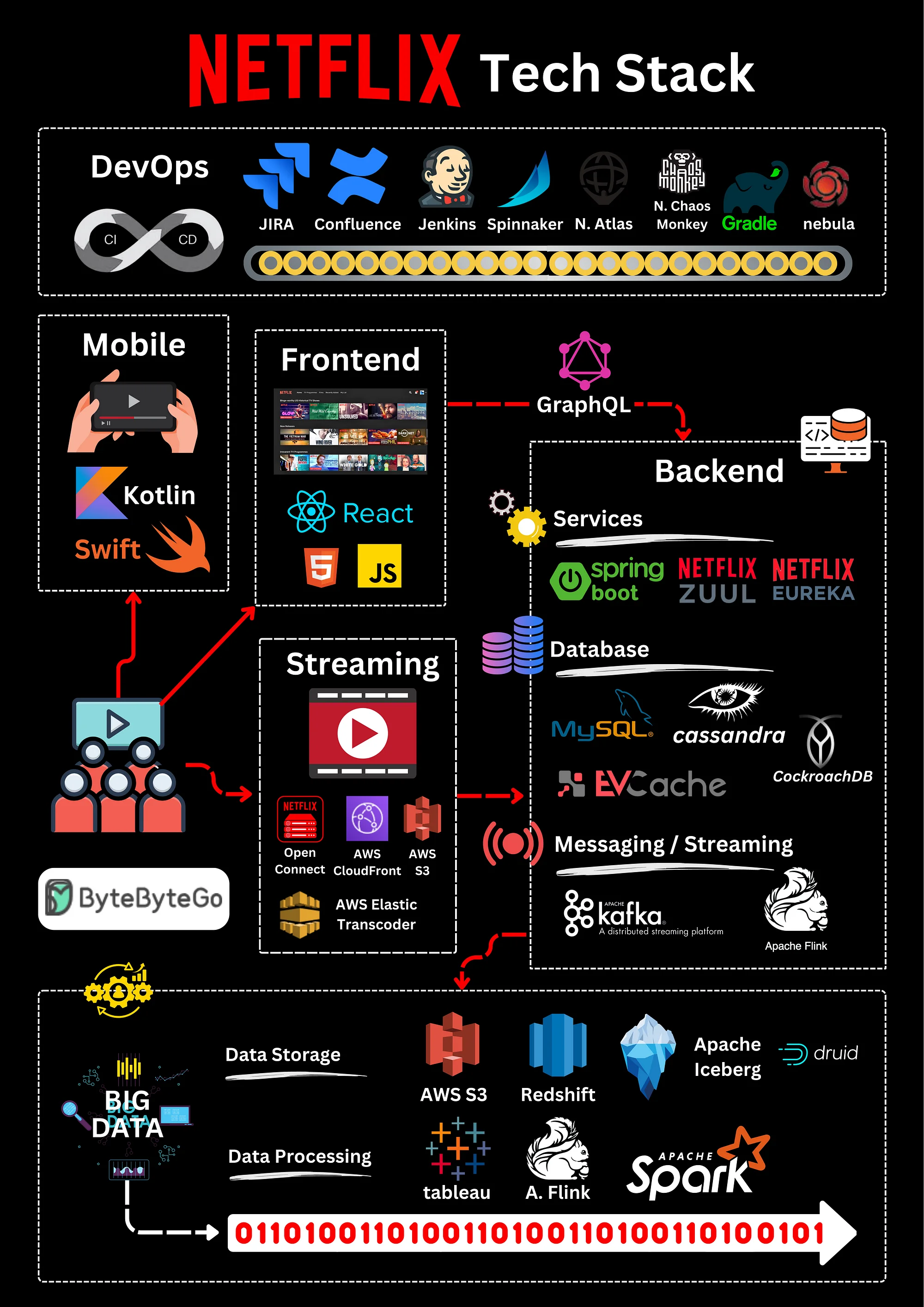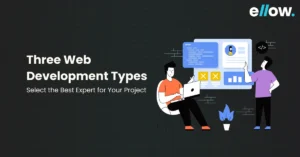In the fast-changing world of technology, it’s really important to know the basics of how digital products, like websites and apps, are made. This is something both the people who make these products (developers) and the people who decide how they’re used in business need to understand.
This brings us to the idea of a “Tech Stack.” This is a key term used when talking about creating software and IT projects. It refers to the combination of programming languages, tools, and technologies that developers use to build apps and websites.
At its core, a tech stack is a combination of programming languages, tools, frameworks, and technologies that developers use to build web and mobile applications.
As of 2023, the proliferation of tech stacks has been significant, with Stack Overflow’s Developer Survey revealing that JavaScript, HTML/CSS, and SQL dominate the top spots in programming languages and technologies used, showcasing the diverse and dynamic nature of modern tech stacks.
The choice of a tech stack is a critical decision that can determine the scalability, performance, and ultimately the success of a project.
High-profile companies like Netflix, Instagram, and Spotify have meticulously selected their tech stacks to handle millions of users daily, leveraging combinations that ensure high performance and reliability.
This selection is not static; it evolves with the company’s needs and the technological landscape, illustrating the importance of adaptability in tech stack configurations. Let’s understand tech stack in more detail.
What is a Tech Stack?
A tech stack is a collection of technologies that are used together to build and run a web or mobile application. It includes everything from the programming languages and frameworks to the servers, databases, and software that handle the project’s needs. Think of it as the building blocks or the ingredients list for creating an app or website.
Modern Tech Stack
With technological advancements, modern tech stacks have evolved to encompass a wide range of tools and services catering to the complexities of today’s digital landscape.
These may include technologies, business intelligence tools, performance monitoring solutions, cloud services, analytics platforms, microservices architectures, and more.
The selection of a modern tech stack depends on factors such as company size, application requirements, scalability needs, and programming preferences.
Front-end Stack
The front-end stack comprises technologies responsible for creating the user interface and handling user interactions within a web application. Common components of a front-end stack include:
- HTML (Hypertext Markup Language): Provides the basic structure and layout of webpages.
- CSS (Cascading Style Sheets): Defines the visual presentation and styling of elements on a webpage.
- JavaScript: Enables dynamic behavior and interactivity on webpages, often utilized alongside frameworks such as React, Vue.js, Angular, or libraries like jQuery.
Back-end Stack
The back-end stack powers the server-side logic and database management of an application. Key components of a back-end stack include:
- Server-side Frameworks: Provide tools and libraries for building server-side logic, handling requests, and managing data. Examples include Node.js, Django, Flask, and Ruby on Rails.
- Database Management Systems (DBMS): Store, retrieve, and manage data efficiently. Popular choices include MySQL, PostgreSQL, MongoDB, and Firebase.
- Operating Systems: Provide a platform for hosting and running the back-end components of an application. Common options include Linux distributions like Ubuntu and CentOS.
Full-stack Tech Stack
A full-stack tech stack encompasses both front-end and back-end technologies, allowing developers to work on both client-side and server-side aspects of an application.
This comprehensive approach is commonly used in the development of desktop web applications. Examples of full-stack technologies include Angular, React, and Vue.js for the front end, coupled with server-side frameworks like Node.js or Django for the back end.
Benefits of the appropriate startup technology stack
1. Cost Efficiency
Choosing technologies tailored to the startup’s needs prevents unnecessary expenditure on features or resources that aren’t essential, ensuring that the startup optimizes its budget effectively.
2. Accelerated Development
An appropriate tech stack expedites the development process, enabling the startup to launch its product or service to market faster, gaining a competitive edge and capturing market opportunities swiftly.
3. Scalability
A well-chosen software development tech stack can seamlessly grow alongside the startup, accommodating increased user demand, integrating new features, and adapting to evolving market dynamics without compromising performance.
4. Community Support
Popular technologies boast extensive communities and support resources, facilitating quick problem-solving, easy access to documentation, and the utilization of third-party tools and libraries, thereby enhancing development efficiency.
5. Security and Compliance
Prioritizing technologies with robust security measures ensures the protection of sensitive data and user information, safeguarding the startup’s reputation and fostering trust among users and stakeholders.
6. Integration Capabilities
A compatible tech stack that seamlessly integrates with essential business tools and services such as analytics platforms, CRM systems, or marketing automation tools streamlines operational processes, enhancing productivity and efficiency.
7. Long-term Viability
Choosing technologies with proven long-term viability and ongoing support ensures the startup builds its foundation on a tech stack that remains relevant and supported, mitigating the risk of obsolescence and technological disruptions.
8. Risk Mitigation
Apt tech stack selection minimizes technical risks throughout the Software Development Life Cycle (SDLC), ensuring a smoother development process with effective risk management strategies, ultimately contributing to project success and sustainability.
Top Factors to Consider While Choosing a Start-up Technology Stack
1. Relevance
Choosing a technology stack that aligns with your start-up’s vision and goals is crucial. The tools you select should complement your business operations and contribute to achieving your objectives. For example, if your focus is on web development, languages like Python may be more relevant than C/C++.
2. Efficiency
Opt for a technology stack that ensures stability, responsiveness, and scalability. While efficient tools might come with a higher initial cost, they often prove to be cost-effective in the long run. Prioritize tools that can handle heavy loads and maintain performance under pressure.
3. Flexibility
The ability of your software to adapt and grow alongside your start-up is essential. Markets evolve, and customer needs change rapidly. Your technology stack should allow for easy integration of new features and updates, ensuring your solution remains competitive and meets evolving demands.
4. Affordability
Consider the financial constraints of your start-up when selecting a technology stack. Licensing fees, hosting costs, and ongoing maintenance can quickly add up. Opt for tools and technologies that offer a balance between functionality and affordability, allowing you to stay within budget without compromising on quality.
Top Companies Tech Stack
1. Netflix Tech Stack
Netflix, the leading entertainment streaming service, relies on a robust and versatile tech stack to deliver seamless experiences across various platforms.
Backend: Utilizing Java, Scala, and Node.js, Netflix ensures efficient handling of user requests and content delivery.
Frontend: To craft captivating user interfaces, Netflix employs React and JavaScript, enabling engaging interactions across browsers, smart TVs, smartphones, and gaming consoles.
Data Storage: Leveraging Apache Cassandra, PostgreSQL, and other databases, Netflix manages vast amounts of user data and content information effectively.
Infrastructure: Operating on Amazon Web Services (AWS), Netflix benefits from scalable and reliable cloud infrastructure, enhancing performance and availability.
DevOps: With tools like Spinnaker, Ribbon, and Eureka, Netflix streamlines deployment, monitoring, and management of its services, ensuring smooth operation.
2. Instagram Tech Stack
Instagram, the popular social media platform, relies on a comprehensive tech stack to provide users with seamless sharing and interaction experiences.
| Component | Technologies & Tools |
|---|---|
| Backend | Python, Django, Node.js |
| Frontend | React, JavaScript, HTML/CSS |
| Data Storage | MySQL, Redis |
| Infrastructure | Amazon Web Services (AWS) |
| DevOps | Jenkins, Docker |
Backend: Instagram utilizes a combination of Python, Django, and Node.js to handle user interactions, content delivery, and data processing efficiently.
Frontend: Crafted with React, JavaScript, and HTML/CSS, Instagram’s front end ensures a smooth and engaging user interface across various devices and platforms.
Data Storage: With MySQL and Redis, Instagram manages user data, content metadata, and session information securely and efficiently.
Infrastructure: Instagram leverages Amazon Web Services (AWS) for scalable cloud infrastructure, enabling reliable performance and quick scalability as user demands fluctuate.
DevOps: Employing tools like Jenkins and Docker, Instagram automates deployment processes, ensuring rapid and reliable updates while maintaining system stability.
3. Google Tech Stack
Google, the tech giant known for its innovation and vast array of services, relies on a powerful tech stack to deliver cutting-edge products and solutions.
| Component | Technologies & Tools |
|---|---|
| Backend | Python, Java, C++ |
| Frontend | Angular, Polymer, JavaScript |
| Data Storage | Bigtable, Spanner, BigQuery |
| Infrastructure | Google Cloud Platform (GCP) |
| DevOps | Borg, Kubernetes, Docker |
Backend: Powered by Python, Java, and C++, Google’s backend infrastructure handles massive data processing, search algorithms, and service orchestration.
Frontend: Utilizing Angular, Polymer, and JavaScript, Google crafts intuitive and responsive user interfaces for its diverse range of applications and services.
Data Storage: With technologies like Bigtable, Spanner, and BigQuery, Google manages vast amounts of data efficiently, supporting real-time analytics and insights generation.
Infrastructure: Google Cloud Platform (GCP) serves as the backbone for Google’s services, providing scalable and reliable cloud infrastructure for computation, storage, and networking.
DevOps: Google utilizes advanced tools like Borg, Kubernetes, and Docker for container orchestration, ensuring seamless deployment and management of services across its infrastructure.
4. Amazon Tech Stack
Amazon, the e-commerce and cloud computing giant, relies on a robust tech stack to power its diverse range of services and operations.
| Component | Technologies & Tools |
|---|---|
| Backend | Java, Python, Ruby |
| Frontend | React, JavaScript |
| Data Storage | Amazon DynamoDB, Aurora, Redshift |
| Infrastructure | Amazon Web Services (AWS) |
| DevOps | AWS Elastic Beanstalk, AWS Lambda |
Backend: Amazon utilizes Java, Python, and Ruby for its backend services, facilitating efficient handling of user requests, transaction processing, and data management.
Frontend: With React and JavaScript, Amazon crafts intuitive and responsive user interfaces for its e-commerce platform, enhancing user experience and engagement.
Data Storage: Leveraging Amazon DynamoDB, Aurora, and Redshift, Amazon manages vast amounts of transactional and analytical data securely and efficiently.
Infrastructure: Amazon Web Services (AWS) forms the foundation of Amazon’s operations, providing scalable and reliable cloud infrastructure for its e-commerce and cloud computing services.
DevOps: AWS Elastic Beanstalk and AWS Lambda streamline deployment and management processes, enabling rapid innovation and scalability while maintaining operational excellence.
5. Uber Tech Stack
Uber, the renowned ride-hailing service, relies on a sophisticated tech stack to power its platform and ensure seamless transportation experiences for millions of users worldwide.
| Component | Technologies & Tools |
|---|---|
| Backend | Python, Go, Node.js, Java |
| Frontend | React Native, JavaScript |
| Data Storage | PostgreSQL, MySQL, Redis |
| Infrastructure | Kubernetes, M3, AWS |
| DevOps | Kubernetes, Jenkins, M3 |
Backend: Uber employs a diverse range of technologies including Python, Go, Node.js, and Java for its backend services. This allows for efficient handling of ride requests, real-time tracking, and data processing.
Frontend: Utilizing React Native and JavaScript, Uber crafts intuitive and responsive user interfaces for its mobile applications, ensuring a seamless booking and ride experience for users.
Data Storage: With PostgreSQL, MySQL, and Redis, Uber manages vast amounts of user data, ride information, and driver details securely and efficiently, enabling quick access and analysis.
Infrastructure: Uber’s tech infrastructure relies on Kubernetes, M3, and AWS for scalable and reliable cloud-based operations. This ensures high availability and performance of its services across regions.
DevOps: Kubernetes facilitates container orchestration, while tools like Jenkins and M3 streamline deployment and monitoring processes, enabling rapid development and deployment of new features.
6. Zomato Tech Stack
Zomato, the popular food delivery and restaurant discovery platform, relies on a robust tech stack to connect users with restaurants and deliver delightful dining experiences.
| Component | Technologies & Tools |
|---|---|
| Backend | Python, Django, Node.js |
| Frontend | React, JavaScript, HTML/CSS |
| Data Storage | MongoDB, PostgreSQL, Redis |
| Infrastructure | AWS |
| DevOps | Jenkins, Docker, Kubernetes |
Backend: Zomato utilizes Python, Django, and Node.js for its backend services, facilitating efficient order processing, restaurant management, and user interactions.
Frontend: Crafted with React, JavaScript, and HTML/CSS, Zomato’s frontend ensures an intuitive and engaging user interface across web and mobile platforms, enabling seamless browsing and ordering experiences.
Data Storage: With MongoDB, PostgreSQL, and Redis, Zomato manages vast amounts of restaurant data, user preferences, and order information securely and efficiently, supporting personalized recommendations and efficient order processing.
Infrastructure: Zomato relies on AWS for scalable cloud infrastructure, enabling reliable performance and quick scalability to handle fluctuating demand for its services.
DevOps: Zomato automates deployment processes using tools like Jenkins, Docker, and Kubernetes, ensuring rapid and reliable updates while maintaining system stability and uptime for its users.
Conclusion
Selecting the right tech stack is crucial for the success of your project or enterprise. There isn’t a universally perfect stack; it depends on your specific needs and goals.
When building your tech stack, consider factors such as the type of project, the expertise of your developer team, and the project’s requirements. It is essential to conduct thorough research and consult with your developers to ensure the best fit.
To streamline this process, platforms like ellow.io offer staffing services to connect you with top-notch stack developers tailored to your project’s needs.
By carefully considering all aspects, including time and cost, you can set your project up for success.
Recommended Reads:
How to become a full stack developer?
5 Best Full Stack Project Ideas in 2024
Full-Stack vs MEAN Stack vs MERN Stack: Which Tech Stack to Choose in 2024?
FAQs
Why is choosing the right tech stack important?
Selecting the appropriate tech stack is crucial as it directly impacts the performance, scalability, and maintainability of your software application.
How do I determine the best tech stack for my project?
Assessing factors such as project requirements, scalability needs, development team expertise, and budget constraints can help in determining the most suitable tech stack for your project.
Can I change my tech stack mid-project?
While possible, changing the tech stack mid-project can be complex and costly. It’s advisable to thoroughly research and plan your tech stack before starting development to avoid such situations.
How can platforms like ellow.io help me find the right developers for my tech stack?
Platforms like ellow.io offer staffing services to connect you with skilled developers experienced in various tech stacks, ensuring you find the right talent tailored to your project’s needs.










